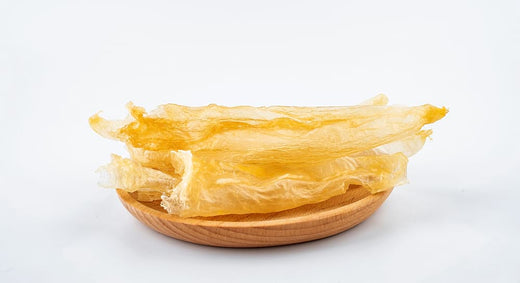While the term "fish maw" encompasses a wide variety of fish bladders, this article will focus on two popular types: Dried Fish Maw and Fried Fish Maw.
Dried Fish Maw (花胶)
Dried fish maw, often referred to as 花胶 (huā jiāo) in Chinese, is the result of a meticulous preparation process. It involves cleaning and thoroughly drying the swim bladder of fish. The most commonly used fish for this purpose include croakers, sturgeon, and more. The process of making dried fish maw consists of several key steps:
- Cleaning: The first step involves meticulous cleaning to remove any impurities or fishy odours. This ensures that the final product is of the highest quality and free from any unpleasant flavours.
- Drying: Once cleaned, the fish maw is either sun-dried or heat-dried. Sun drying involves exposing the swim bladders to the sun's rays, allowing natural evaporation to remove moisture gradually. Heat drying, on the other hand, employs controlled temperatures to expedite the drying process. Both methods aim to reduce the moisture content significantly.
- Preservation: After thorough drying, the fish maw is carefully stored to maintain its quality and flavour. This preservation ensures that it can be enjoyed throughout the year, even when certain fish species are not in season.
The result of these steps is a lightweight, translucent, and delicate product that, when rehydrated, has a gelatinous, slightly chewy texture. Dried fish maw is often used in soups, stews, and braised dishes, where it absorbs flavours and imparts a unique, savoury taste to the dish.
Fried Fish Maw (鱼鳔)
In contrast to dried fish maw, 鱼鳔 (yú biào) or fried fish maw undergoes a distinctive cooking process. This type of fish maw is created by deep-frying the dried fish bladder until it becomes crispy and takes on a golden brown hue. This culinary transformation provides fried fish maw with a crunchy texture, setting it apart from the chewy consistency of its dried counterpart.
The process of making fried fish maw typically includes the following steps:
- Rehydration: Prior to frying, dried fish maw must be soaked in water until it softens and regains its original size. This step is essential to ensure that the fish maw becomes tender after frying.
- Deep Frying: The rehydrated fish maw is then deep-fried in hot oil until it puffs up and turns golden brown. This frying process not only adds a delightful crunch but also enhances its flavour by creating a delicate balance of crispiness and tenderness.
Fried fish maw is a versatile ingredient that can be used in various dishes, such as stir-fries, salads, and soups. Its unique texture makes it an excellent choice for adding a contrasting element to recipes, enhancing both taste and visual appeal.
Fish maw, available in various forms, continues to be a sought-after ingredient in Asian cuisine, celebrated for its culinary versatility and nutritional benefits. Dried fish maw, known as 花胶 (huā jiāo), offers a chewy texture and is commonly used in soups and braised dishes. On the other hand, 鱼鳔 (yú biào) or fried fish maw, with its crispy and golden exterior, adds a delightful crunch to various recipes.
Whether you prefer the tender resilience of dried fish maw or the satisfying crunch of fried fish maw, both types offer a delectable way to savour the unique qualities of this prized ingredient. The rich history and continued popularity of fish maw in culinary traditions underscore its enduring appeal in Asian cuisine.
Related Content:
Premium Fish Maw: A Natural Collagen for Healthy Skin and Joints
Why Is Fish Maw So Expensive? : The Pricey Perfection
Nourishing from Within: Unveiling the Health Benefits of Fish Maw
From Dried to Delicious: A Step-by-Step Guide to Preparing Dried Fish Maw for Cooking
Fish Maw Soup: Traditional Recipe, Tips & Variations
How to Cook Fish Maw: Recipes, Tips & Health Benefits
Fish Maw Benefits: Nutritional Value, Health Benefits & More

